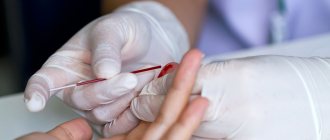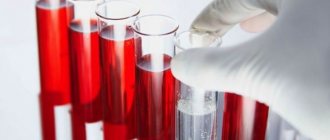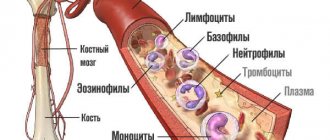Causes of lymphocytosis
If a baby is diagnosed with lymphocytosis, this is the first sign of progression of some disease in the body. Increased lymphocytes in the blood of a child indicate that the body is finding it difficult to cope with a progressive disease; an increased number of white blood cells is a sign of the fight against an infectious agent.
The main reasons for the increase in lymphocytes in a child include various diseases, among which it is necessary to highlight:
- hepatitis;
- measles;
- rubella;
- colds;
- whooping cough;
- tuberculosis;
- the presence of parasites in the body;
- herpes infection.
Also among the diseases it is necessary to note toxoplasma, adenoviruses, chickenpox, brucellosis. There are also serious diseases, for example, malignant thymoma, Smith or Franklin disease, leukemia. If lymphocytes are elevated in a child, this is not a sign of the development of a tumor disease or viral infection. This manifestation may be due to the fact that the baby’s body lacks the necessary vitamin complex, for example, B12. Take into account! After taking medications that inhibit neutrophils, it is not recommended to take a blood test for some time (unless there is an urgent need), since the child’s lymphocytes will be higher than normal.
Non-infectious diseases may also be among the reasons for the increase in lymphocytes in a child’s blood. These include:
- insufficient amount of vitamin (this leads to the development of vitamin deficiency);
- bronchial asthma;
- hyperthyroidism.
Elevated rates indicate the development of autoimmune diseases. The same indicators will be after removal of the spleen or the results of exposure to a certain number of medications.
What analysis reveals an increase in lymphocytes?
Lymphocytosis is diagnosed through a routine complete blood count. It always indicates two values of lymphocytes - absolute and relative as a percentage. Lymphocytes are designated in a general blood test as LYM; when indicated as a percentage, the letter “L” may simply appear.
Most often, this analysis is enough to judge the viral nature of the disease, but if there is a suspicion that the child has an oncological process, then more specific examinations are prescribed.
This includes bone marrow puncture and lymph node biopsy .
In addition, to detect the virus, a nasal swab can be prescribed for RIF (immunofluorescence reaction) in acute respiratory diseases. This analysis is most informative only in the first 3 days from the onset of the disease.
If infectious mononucleosis is suspected, blood from a vein is tested for Abshane-Barr virus, cytomegalovirus using enzyme-linked immunosorbent assay (ELISA) or PCR (polymerase chain reaction).
Ancillary diagnostic methods include: ultrasound of lymph nodes, ultrasound of the abdominal cavity, ultrasound of the thyroid gland.
In controversial and ambiguous cases, a biochemical blood test can be performed to determine specific markers of inflammation, such as, for example, CRP (C-reactive protein).
Symptoms
Elevated lymphocytes in a child are accompanied by the following symptoms:
- dyspnea;
- deterioration of general condition;
- fever;
- lethargy;
- sleep disturbance;
- the appearance of a rash;
- increase in body temperature.
The child will become capricious and his lymph nodes will enlarge. Against the background of the disease, the spleen and liver may increase in size.
Take into account! After recovery, the level of lymphocytes does not stabilize immediately; this may take from several weeks to several months. The process of lowering the level of lymphocytes is gradual.
When to see a doctor
If you have any of the above diseases and symptoms, you should consult a doctor. The doctor will assess the situation, taking into account the baby's age. If a child has elevated lymphocytes, then blood donation is prescribed to check the level of monocytes. If it is exceeded, this is a sign of a viral infection.
An immunologist-infectious disease specialist at Meditsina JSC (academician Roitberg’s clinic) will determine the cause and eliminate it in a short time, carrying out a suitable diagnosis. The clinic is located in the center of Moscow.
Diagnostics
Diagnosis depends on the cause, on what is affecting the child’s body that led to an increased level of white blood cells. The main diagnostic methods include computed tomography or ultrasound. A number of laboratory tests are also prescribed, and the child is required to undergo a blood test. Diagnostics allows you to draw conclusions, determine the level of danger and risks, and prescribe effective treatment (depending on what was the cause).
Red blood: what is it?
Yeah. The blood test is divided into two parts. The first part is the so-called “red blood”, that is, hemoglobin, red blood cells, platelets and color index. All this fraternity is responsible for the transfer of oxygen into cells and does not suffer much during infection. You and I just need to quickly go through the standards and, making sure that everything is fine, move on to the second part.
Norms
Hemoglobin (aka Hb) is measured in grams per liter (!) of blood and is responsible for the transport of oxygen.
A one-month-old child has a hemoglobin norm of 115-175 (this is not an adult, everything is more complicated here), at six months - 110-140 - the same as you and I, and so, in fact, right up to 10-12 years. 110-140 (145 according to other sources) grams per liter of blood.
Red blood cells , also known as RBCs, are cells in which hemoglobin floats in the blood. They carry oxygen with the help of hemoglobin. The norm for a child per month will be 3.8-5.6 - attention! - trillions of red blood cells per liter of blood. A one-year-old child (like an adult) already has fewer of these same trillions - 3.5-4.9 per liter of blood. What to do - if you pump out blood for analysis in liters, everything has to be counted in trillions. No problem, it will be easier next time.
Reticulocytes , also known as RTC, their number is measured, thank God, as a percentage. These are, so to speak, young red blood cells; they should not be more than 15% in children under one year old and no more than 12% in children over one year old or in adults. The lower limit of normal for reticulocytes is 3%. If there are fewer of them, the child is on the verge of anemia, and measures must be taken as soon as possible.
Platelets . English abbreviation PLT. There are significantly fewer of them than red blood cells - their number is measured “only” in billions per liter of blood, the norm is from 180 to 400 for children under one year old and from 160 to 360 for children over one year old or in adults. Platelets are actually not cells at all, but rather fragments of a giant precursor cell, from these fragments, in which case blood clots are formed - for example, to stop bleeding if the baby, God forbid, gets injured.
ESR (ESR). These are not even cells at all, but an indicator of the erythrocyte sedimentation rate - the higher this rate (and this is not a car, here the speed is measured in millimeters per hour), the more active the inflammatory process, for which you may have been recommended to take a blood test. ESR norms at 1 month are 4-10, at 6 months 4-8, but from one year to 12 years - from 4 to 12 mm per hour. Then the norms of that same ESR will also differ depending on gender, but that’s a completely different story.
In addition to these indicators, there are many others - hematocrit (HCT), red blood cell distribution width (RDWc), mean erythrocyte volume (MCV), mean erythrocyte hemoglobin content (MCH) and even mean erythrocyte hemoglobin concentration (MCHC). All these indicators serve to diagnose anemia, so it would be better for you and me (we are talking about infections, remember?) to postpone their discussion until later.
What is much more important for us is not the oxygen transport system, but the body’s defense system against infections. This is the so-called white blood, leukocytes. Here we will dwell on it in very, very detail.
Treatment
If the child’s lymphocytes are higher than normal, the doctor determines the cause and selects the most effective treatment. Elevated lymphocytes in the child’s blood indicate that the immune system is resisting the disease developing in the body. Medicines are not prescribed in this situation. The first thing the specialist recommends is to improve the baby’s daily routine, which should consist of proper sleep patterns, walks in the fresh air, and rest. If lymphocytes in a child’s blood are elevated, you need to provide him with adequate nutrition.
If the process is accompanied by elevated temperature, the doctor may prescribe antipyretic drugs. Also, in some cases, medications are prescribed that have anti-inflammatory and antiviral effects. Another task for the specialist is to determine whether the child’s lymphocytes are elevated as a result of a tumor or not. If the cause is a tumor, the doctor’s further tactics are determined by the form of the tumor and the activity of development. In this situation, the doctor may prescribe chemotherapy or a bone marrow transplant. It is not recommended to ignore the symptoms or doctor’s recommendations by self-medicating.
Prevention
To prevent elevated lymphocytes in a child’s blood, you need to adhere to the following preventive actions:
- proper nutrition (the diet should be balanced);
- playing sports (loads should be moderate);
- avoid hypothermia (dress your baby according to the weather);
- regular examination by doctors.
It is recommended to regularly take blood tests to ensure that your baby does not form bad habits.
Do I need to prepare for the analysis?
To obtain a more reliable picture of a blood test, preparation is necessary for its implementation.
Mode
Before the analysis, it is not recommended to eat food 12 hours before the test (in children under 1 year, several hours).
Medications
Some medications can distort the blood picture. Such drugs include glucocorticoid hormones, chemotherapeutic drugs, cytostatics, and neuroleptics.
What can distort the results
Stress, heavy physical activity, food, and taking certain medications can distort the results.
Approaches to the treatment of conditions in which lymphocytes in the blood of a child increase
Treatment of children with lymphocytosis depends on the cause that caused such changes in the general blood test. If we are talking about a viral infection, then treatment in most cases is symptomatic. That is, at a high temperature, antipyretic drugs are given, in the presence of rhinitis, nasal sanitation is prescribed, in the presence of a cough, antitussive drugs and/or inhalation therapy, and so on.
Be sure to prescribe plenty of fluids and bed rest for the febrile period.
To date, there are no antiviral drugs that have undergone multicenter randomized studies indicating their effectiveness!
Therefore, the prescription of these drugs, which have flooded the entire pharmacy chain with beautiful advertising and promises of a quick recovery, is not justified. The only exceptions are drugs such as oseltamivir (used for influenza), acyclovir (prescribed for herpes infections and in some cases for chickenpox) and ganciclovir and its derivatives (for cytomegalovirus infection). It should be mentioned that the currently popular homeopathic medicines in the treatment of viral infections also have no effectiveness, that is, they do not work.
For some viral (measles, rubella, hepatitis B and A, mumps) infections, the only effective means of prevention today remains vaccination.
For the development of these diseases, etiotropic treatment, that is, acting on a specific pathogen, is not available anywhere in the world today!









